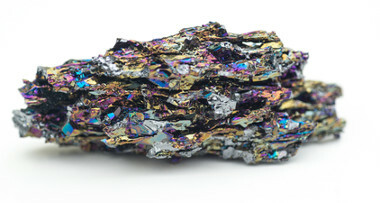Previously, the classification of chemical elements in the periodic table was made into the following groups: metals, non-metals and metalloids. However, the International Union of Pure and Applied Chemistry (IUPAC) recommends that this term “metalloid” is no longer used, as its use is inconsistent in different languages. Thus, the current classification of elements is in metals, non-metals or non-metals and semimetals.
The elements generally classified as semi-metals are seven:boron (B), silicon (Si), germanium (Ge), arsenic (As), antimony (Sb), tellurium (Te) and polonium (Po). These elements appear on the periodic table forming a diagonal line, similar to a ladder, that runs between metals and non-metals.
They are classified as such because they have intermediate properties between metals and non-metals. For example:
- They have a metallic shine: like metals;

silicon mineral
- Fragment: like non-metals, semi-metals shatter, that is, they are brittle, meaning they cannot be molded;
- Can form cations or anions, depending on the situation:
metals are electropositive, forming cations (positively charged species), while non-metals are electronegative and form anions (negatively charged species);- Are electricity semiconductors: metals are good conductors of electricity, while non-metals are insulating, that is, they do not conduct electrical current.
Do not stop now... There's more after the advertising ;)
This last property of semimetals is the most important, as it makes them valuable in reason for its wide application in semiconductors for use in electronic equipment such as transistors, chips of computers, microprocessors, diodes, besides the use in solar cells.
A notable example of this application is the silicon, which is the main raw material for the production of most circuits and chips electronics. That's why a region located in California, United States, where an industrial center is concentrated with several information technology and computing companies, among others, it started to receive the name of Silicon Valley.

Silicon blade used in chip production
Returning to the classification of elements as semimetals, it is noteworthy that, currently, only the division into metals and non-metals is used. This is because the IUPAC does not define or indicate which elements are classified as semi-metals, and various criteria can be used for this classification. Depending on the criteria used, a semimetal can be classified as a metal or a non-metal.
Generally, we have the following:
Ametals: boron, silicon, arsenic and tellurium;
Metals: germanium, antimony and polonium.
By Jennifer Fogaça
Graduated in Chemistry
Would you like to reference this text in a school or academic work? Look:
FOGAÇA, Jennifer Rocha Vargas. "Semimetals"; Brazil School. Available in: https://brasilescola.uol.com.br/quimica/semimetais.htm. Accessed on July 27, 2021.



